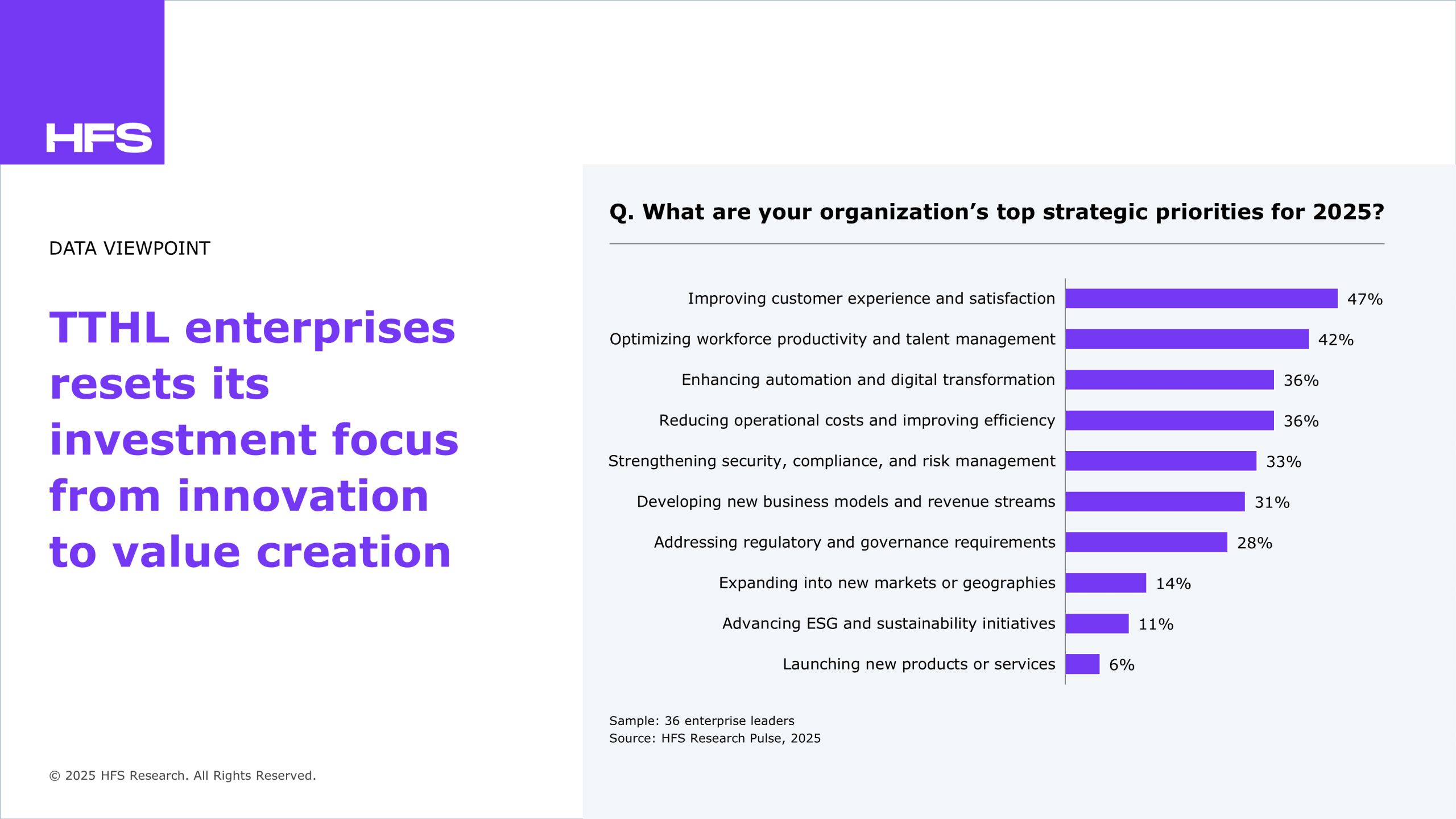
Our recent HFS pulse study shows that Travel, Transportation, Hospitality, and Logistics (TTHL) enterprise leaders are reprioritizing around efficiency and customer value, while innovation slightly takes a backseat. Most (47%) say their top strategic priority is improving customer experience and satisfaction, dwarfing the 6% prioritizing new product launches and the 14% eyeing geographic expansion.
Customer experience is no longer just a retention lever, but the growth engine: More than half of organizations say improving customer experience and satisfaction is their strategic priority. This is a significant signal: enterprises now see experience as a retention tool and a growth lever. In low-growth environments, customer loyalty and satisfaction are the most controllable levers of revenue stability. But this also means experience investments must deliver measurable outcomes, not just vanity metrics. As enterprises continue to place their bets on experience-led strategies that maximize value from existing offerings, channels, and relationships, personalization, responsiveness, and journey orchestration are moving from ‘nice to have’ to mission-critical. That means improving service delivery, enhancing personalization, and closing experience gaps across digital and physical channels.
This means evaluating service partners through a new lens for enterprise buyers: Can they increase customer lifetime value, not just net promoter scores? Customer experience (CX) initiatives that don’t deliver measurable business outcomes are dead on arrival.
Productivity and digital are now survival plays: While customer experience (CX) remains the top priority in the boardroom, workforce productivity and digital transformation follow closely, with 42% and 36% of organizations identifying them as strategic priorities, respectively. This is no longer about generic ‘transformation.’ It’s about cost control, integrating technologies such as generative AI and automation, and driving talent efficiency in a climate of tightening labor markets and intensifying margin pressures. This shift is not merely about streamlining operations; it’s about ensuring enterprise viability amid the convergence of talent shortages, rising costs, and operational complexity.
Enterprises are investing in fewer tools, but they expect more from them. Upskilling, intelligent automation, and workforce agility aren’t future goals; they’re table stakes. Enterprise leaders must pressure-test their transformation programs: Are they reducing friction and cost? Are they building digital resilience? If not, they’re likely just window dressing.
Innovation and ESG are being deferred but not abandoned: Launching new products and advancing ESG initiatives are currently the lowest priorities, at 6% and 11%, respectively. This doesn’t mean innovation and sustainability are irrelevant; they’re presently considered long-term, not immediate, value drivers. This de-prioritization reflects a need to stabilize the core business before pursuing long-term transformation. But this is a dangerous trade-off if not managed carefully. Delaying innovation and ESG investment creates long-term risk exposure in brand trust, regulatory readiness, and future competitiveness. The challenge for enterprise leaders is to reposition these initiatives as enablers of efficiency and compliance, not as discretionary spending.
Enterprise leaders appear to be focused on stabilizing and optimizing their core before branching out. But providers should frame ESG and innovation offerings as long-term enablers of efficiency, compliance, and brand trust to stay aligned with this cautious outlook.
Enterprise leaders aren’t looking for new frontiers but ways to thrive within tighter bounds. They are laser-focused on optimizing their existing operations, people, and customer relationships. Service providers that align with these priorities by offering scalable, experience-led, and efficiency-enhancing solutions will lead the charge. Enterprise leaders must double down on initiatives that make their organizations more responsive, efficient, and experience-led. That means prioritizing platforms and partners that solve immediate problems, not those peddling vague transformation journeys.
Service providers must recalibrate quickly, as this is the time to prove their worth by delivering tangible outcomes, not speculative innovations. Those who can meet enterprise clients where they are focused inward and operating smarter will earn both trust and long-term relevance.
Register now for immediate access of HFS' research, data and forward looking trends.
Get StartedIf you don't have an account, Register here |
Register now for immediate access of HFS' research, data and forward looking trends.
Get Started